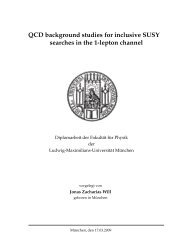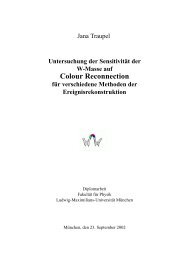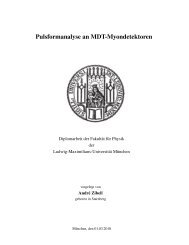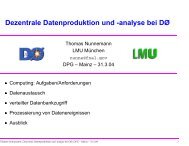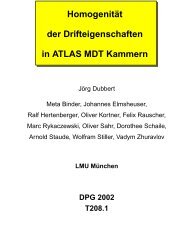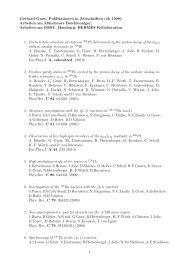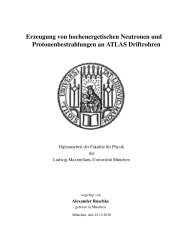development of micro-pattern gaseous detectors – gem - LMU
development of micro-pattern gaseous detectors – gem - LMU
development of micro-pattern gaseous detectors – gem - LMU
You also want an ePaper? Increase the reach of your titles
YUMPU automatically turns print PDFs into web optimized ePapers that Google loves.
6.2. Rise Time Dependence on Induction - Field 69<br />
electrode <strong>of</strong> the undermost foil GEM1 resulting in an induced pulse on the anode.<br />
For these measurements the data was supplied to the flash ADC via the home-made ELab preamplifier<br />
since it shows less internal response time and higher gain than the CATSA82.<br />
6.2.1 55 Fe Measurement with Eind- Field Variation<br />
The iron source was placed centrally on the active area <strong>of</strong> the detector and the induction<br />
field was varied in a range <strong>of</strong> 0.05 kV/cm ≤ Eind ≤ 2.33 kV/cm for each data sample <strong>of</strong><br />
Nsample = 50 × 10 3 events (see Fig. 6.9).<br />
rise time [ns]<br />
800<br />
700<br />
600<br />
500<br />
400<br />
300<br />
200<br />
100<br />
Edrift<br />
55Fe Rise Time vs Eind<br />
cm<br />
kV<br />
= 1.25<br />
Etrans1,2<br />
= 2.00<br />
Δ U = 360 V<br />
GEM3<br />
Δ UGEM2<br />
= 320 V<br />
Δ U = 320 V<br />
GEM1<br />
cm<br />
kV<br />
TDet=<br />
297 ± 4 K<br />
p = 1030 ± 10 mbar<br />
Det<br />
Cu anode seg<br />
preamp: ELab<br />
Ar:CO2<br />
93:7 @ 1 bar<br />
Measurements<br />
MAGBOLTZ sim1 Ar/CO =93/7 p=1040mbar 301K<br />
2<br />
MAGBOLTZ sim2 Ar/CO2=93/7<br />
p=1040mbar 298K<br />
MAGBOLTZ sim3 Ar/CO2=93/7<br />
p=1040mbar 293K<br />
MAGBOLTZ sim4 Ar/CO =93/7 p=1030mbar 298K<br />
2<br />
0<br />
0 0.5 1 1.5 2 2.5<br />
Eind[kV/cm]<br />
Figure 6.9: 55 Fe signal rise time as a function <strong>of</strong> Eind. (Data is indicated by black dots and guiding line).<br />
MAGBOLTZ simulations for drift time <strong>of</strong> electrons in 3 mm induction gap are plotted (see legend). Concerning<br />
also the intrinsic rise time <strong>of</strong> the preamplifier results in a good approximation for the plateau at high fields (red<br />
crosses and green triangles).<br />
The accessible range is limited by frequent discharges at fields Eind > 2.33 kV/cm. A closer look at<br />
Fig. 6.9 shows that the signal rise time starts at approximately 650 ns (indicated by the black dotted<br />
data points in the figure). Increasing the induction field strength results in an exponential decrease<br />
reaching a plateau <strong>of</strong> 100 ns rise time at around 0.8 kV/cm. The rapid drop in signal rise time is due<br />
to the increase in drift velocity over one magnitude for at 0.05 kV/cm ≤ Eind ≤ 0.8 kV/cm (see<br />
Fig. 6.6). However, in the area <strong>of</strong> the plateau the variation <strong>of</strong> the drift velocity with field strength is<br />
no longer strong; it is only <strong>of</strong> about 10%. To illustrate this the drift times <strong>of</strong> electrons from the lowest<br />
foil GEM1 to the anode are simulated with MAGBOLTZ and additionally plotted in the figure. It is



